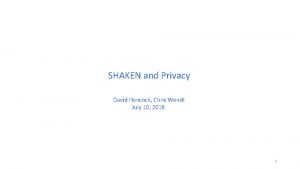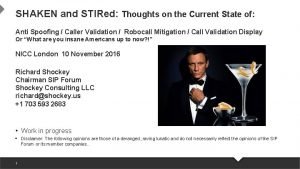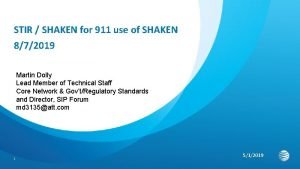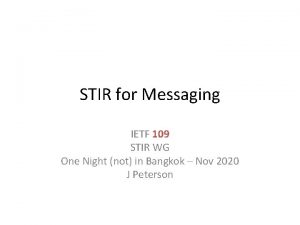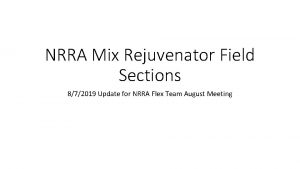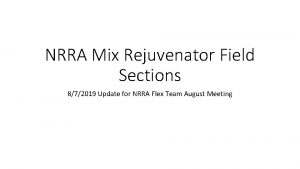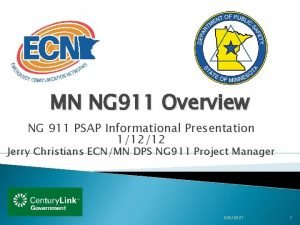STIR SHAKEN for 911 use of SHAKEN 872019











- Slides: 11

STIR / SHAKEN for 911 use of SHAKEN 8/7/2019 Martin Dolly Lead Member of Technical Staff Core Network & Gov’t/Regulatory Standards and Director, SIP Forum md 3135@att. com 1 5/1/2019

Topics to Consider for 911 use of SHAKEN • What is being Attested to? • Is there a need to Attest to the Calling Party in addition to the Priority Attestation? • Will a CVT be invoked? • Are 911 calls ever diverted? • Are new “Verstat” values needed? • Discussion on Standards Work Plan • • • 2 ATIS/IPNNI committees 3 GPP IETF

The PASSpor. T “shaken” extension shall include both an attestation indicator (“attest”), as described in section 5. 2. 3 and an origination identifier (”origid”) as described in section 5. 2. 4. The SHAKEN PASSpor. T token would have the form given in the example below: Protected Header { "alg": "ES 256", "typ": "passport", "ppt": "shaken", "x 5 u": "https: //cert. example. org/passport. cert" } Payload { "attest": "A", "dest": {"tn": ["12125551213 "]}, "iat": 1443208345, "orig": {"tn": "12155551212"}, "origid": "123 e 4567 -e 89 b-12 d 3 -a 456 -426655440000" 3 In addition to attestation, the unique origination identifier (“origid”) is defined as part of SHAKEN. This unique origination identifier should be a globally unique string corresponding to a Universally Unique Identifier (UUID) (RFC 4122). The origid will identify: • Signing Carrier • Carrier Customer/Access Carrier • Entry Gateway

Signing RPH for NS/EP • This specification defines a new JSON Web Token claim for "rph", which provides an assertion for information in ’SIP Resource-Priority’ header field. • The creator of a PASSpor. T object adds a "ppt" value of "rph" to the header of a PASSpor. T object, in which case the PASSpor. T claims MUST contain a "rph" claim, and any entities verifying the PASSpor. T object will be required to understand the "ppt" extension in order to process the PASSpor. T in question. • • A PASSPor. T header with the "ppt“ included will look as follows: { "typ": "passport", "ppt": "rph", "alg": "ES 256", "x 5 u": "https: //www. example. org/cert. cer" } 4

Signing RPH for NS/EP Specifically, the "rph" claim includes an assertion of the priority level of the user to be used for a given communication session. The value of the "rph" claim is an Object with one or more keys. Each key is associated with a JSON Array. These arrays contain Strings that correspond to the r-values indicated in the ’SIP Resource- Priority’ header field. { "orig": {"tn": "12155550112"}, "dest": {["tn": "12125550113"]}, "iat": 1443208345, "rph": {"auth": ["ets. 0", "wps. 0"]} } After the header and claims PASSpor. T objects have been constructed, their signature is generated normally per the guidance in [RFC 8225] using the full form of PASSPor. T. 5

RFC 7135 - Registering a SIP Resource Priority Header Field Namespace for Local Emergency Communications This document creates the new Session Initiation Protocol (SIP) Resource Priority header (RPH) field namespace 'esnet' for local emergency usage and registers this namespace with IANA. Below is an example of a Resource-Priority header field using the 'esnet' namespace: Resource-Priority: esnet. 0 The relative priority order for the 'esnet' namespace is as follows: Defined in the NENA i 3 standard (NENA-STA-010). (lowest) esnet. 0 NENA-STA-010 specifies the use of "esnet. 1" for esnet. 1 9 -1 -1 calls (i. e. , emergency calls that traverse an ESInet) esnet. 2 and "esnet. 0" for callback calls (at least within the ESInet). "esnet. 2" is defined for "Calls related to an incident in esnet. 3 progress which are deemed critical" e. g. , calls between (highest) esnet. 4 6 agencies/PSAP authorities. Uses for "esnet. 3" and "esnet. 4" are not defined.

Proposed PASSpor. T object and Claim for Emergency Services NETwork { "typ": "passport", "ppt": "rph", "alg": "ES 256", "x 5 u": "https: //www. example. org/cert. cer" } { "orig": {"tn": “Cg. PN"}, "dest": {["tn": “ 911 or URN-SOS"]}, "iat": 1443208345, "rph": {“ESorig": [“esnet, x"]} } { "orig": {"tn": “Emerg. Net Num"}, "dest": {["tn": “Cg. PN that originated emergency call"]}, "iat": 1443208345, "rph": {“EScallback": [“esnet, x"]} } 7

Deployment Assumptions for NS/EP RPH signing is only performed by the authenticating NS/EP service provider The authenticating NS/EP service provider will remove TN Identity Header prior to performing NS/EP authentication NS/EP call information will never be provided to a 3 rd party CVT for data analytics An NS/EP carrier will use the same certificates for signing RPH, as they use for TN signing Based on local policy, an NS/EP service provider may choose to honor NS/EP calls without a signed RPH or process with normal priority l l l l This may change over time taking into account maturity of signed PRH deployments and knowledge of the adjacent carrier As with TN siging, RPH signing will not survive if there is interworking with the PSTN 8

Signaling Verification Verstat tel URI parameter in the P-Asserted-Identity TN Validation Passed or FROM header field in a SIP requests – TN Validation Failed P-Asserted-Identity: tel: +14085264000; verstat=TN-Validation-Passed – No TN Validation – Future: same values above for CNAM – Security Considerations • • • 9 The Verification Function must drop a verstat tel URI parameter received in an INVITE If the terminating UE does not support the "verstat" parameter value, it must discard the parameter The terminating UE will act on the "verstat" parameter value, if the 200 (OK) response to the UE REGISTER includes a Feature-Caps header field, as specified in RFC 6809°[190], with a "+g. 3 gpp. verstat" header field parameter

Topics to Consider for 911 use of SHAKEN • What is being Attested to? • Is there a need to Attest to the Calling Party in addition to the Priority Attestation? • Will a CVT be invoked? • Are 911 calls ever diverted? • Are new “Verstat” values needed? • Discussion on Standards Work Plan • • • 10 ATIS/IPNNI committees 3 GPP IETF © 2015 AT&T Intellectual Property. All rights reserved. AT&T and the AT&T logo are trademarks of AT&T Intellectual Property. AT&T Proprietary (Internal Use Only) Not for use or disclosure outside the AT&T companies except under written agreement.

Thank you. 11 © 2015 AT&T Intellectual Property. All rights reserved. AT&T and the AT&T logo are trademarks of AT&T Intellectual Property. AT&T Proprietary (Internal Use Only) Not for use or disclosure outside the AT&T companies except under written agreement.
 Stir shaken rfc
Stir shaken rfc Verstat parameter
Verstat parameter P-attestation-indicator
P-attestation-indicator Used to pick up or hold hot objects
Used to pick up or hold hot objects What is a test tube holder used for in chemistry
What is a test tube holder used for in chemistry Refill friction stir spot welding
Refill friction stir spot welding Champa rice memes
Champa rice memes What are the characteristics of percussion instruments
What are the characteristics of percussion instruments Iron ring laboratory apparatus uses
Iron ring laboratory apparatus uses Fast food thesis statement
Fast food thesis statement Stir you up by way of reminder
Stir you up by way of reminder We will not be moved when everything around is shaking
We will not be moved when everything around is shaking
